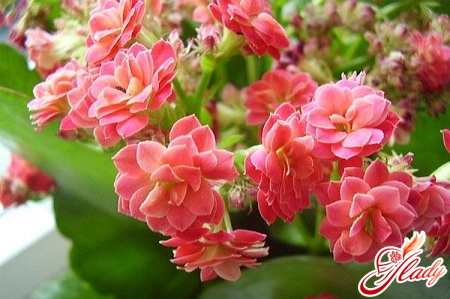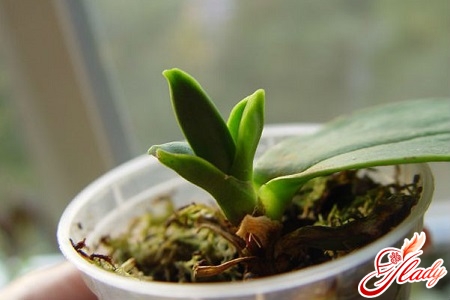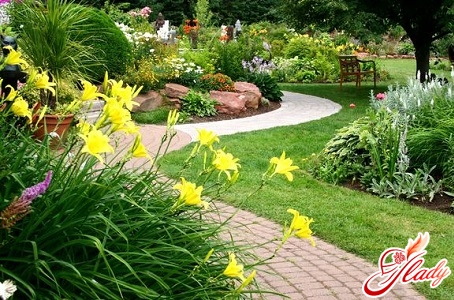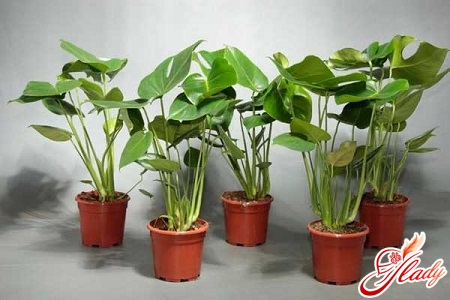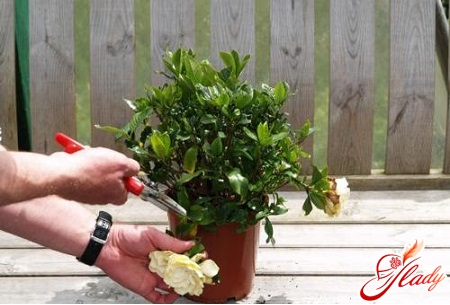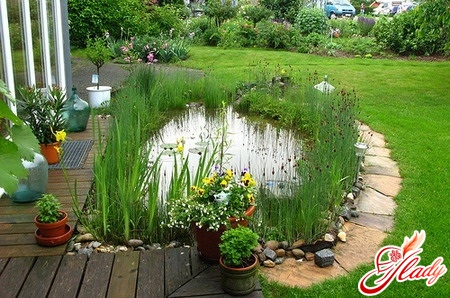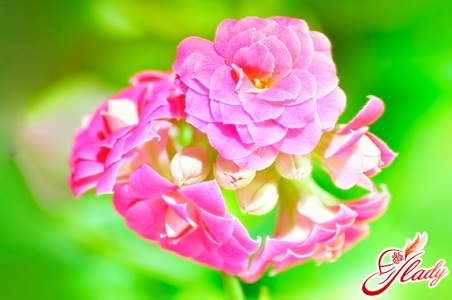 Many people who are not experienced in gardeningKalanchoe is associated with a houseplant that has medicinal properties and is not particularly decorative. Meanwhile, this houseplant is far from the only species that we are used to seeing on the windowsills of our grandmothers' houses. Among Kalanchoe, there are also beautifully flowering specimens that have become very, very popular today. And among them is Kalanchoe Blossfeldiana, which can be bought in almost any flower shop. However, having bought this flower in a store or received it as a gift, not everyone can keep it for a long time and wait for it to bloom again. And the thing is that indoor flowers grown in greenhouses, which are then sold, undergo special treatment. Firstly, the plant is provided with a special light regime that promotes lush flowering, and secondly, it is treated with growth stimulants. It is very difficult to create similar conditions for a flower at home. That is why Kalanchoe dies soon after flowering, and the pot with the plant is sent to the trash can. And this is despite the fact that Kalanchoe Blossfeldiana is considered an unpretentious plant that does not require special care and any special conditions of maintenance. Not many people know that with transplantation and proper care it is quite possible to save the flower and even propagate it, obtaining new specimens adapted to indoor conditions. How to do this and what this indoor plant is, we will try to find out.
Many people who are not experienced in gardeningKalanchoe is associated with a houseplant that has medicinal properties and is not particularly decorative. Meanwhile, this houseplant is far from the only species that we are used to seeing on the windowsills of our grandmothers' houses. Among Kalanchoe, there are also beautifully flowering specimens that have become very, very popular today. And among them is Kalanchoe Blossfeldiana, which can be bought in almost any flower shop. However, having bought this flower in a store or received it as a gift, not everyone can keep it for a long time and wait for it to bloom again. And the thing is that indoor flowers grown in greenhouses, which are then sold, undergo special treatment. Firstly, the plant is provided with a special light regime that promotes lush flowering, and secondly, it is treated with growth stimulants. It is very difficult to create similar conditions for a flower at home. That is why Kalanchoe dies soon after flowering, and the pot with the plant is sent to the trash can. And this is despite the fact that Kalanchoe Blossfeldiana is considered an unpretentious plant that does not require special care and any special conditions of maintenance. Not many people know that with transplantation and proper care it is quite possible to save the flower and even propagate it, obtaining new specimens adapted to indoor conditions. How to do this and what this indoor plant is, we will try to find out.
Biological Description
Kalanchoe Blossfeld is native to the island of Madagascar.This is a perennial plant, related to succulents and represented by more than two hundred species. The flower grows as a small compact bush no more than thirty centimeters high. It has fleshy dark green leaves with a smooth shiny surface, serrated edges and a reddish border. The leaves are small, ovoid, reaching seven centimeters in length, collected in rosettes. Quite long peduncles rise above the rosette of leaves, crowned with a lush bouquet of small tubular flowers, of which there can be more than sixty in an inflorescence. Flowers of different species of Kalanchoe blossfeldiana are white, orange, red, yellow, purple or pink. There are varieties with simple and double flowers. This indoor succulent blooms for a long time: from spring to autumn. The duration and frequency of flowering, as well as the development of the plant itself and the laying of buds, are affected by the length of daylight hours. It is the short daylight hours that ensure the lush and regular flowering of this plant. And this is perhaps the only feature of this indoor flower. In all other respects, it is unpretentious: it does not require special care and specially created conditions of maintenance. Note that in addition to being decorative, this succulent also has medicinal properties, like other types of Kalanchoe.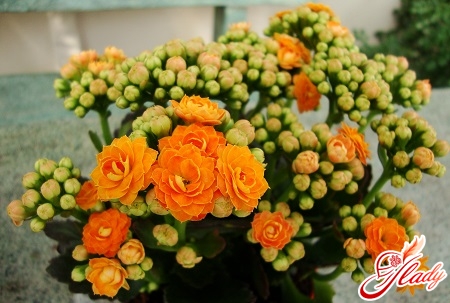
Care of the plant
Becoming the owner of this beautiful indoorflower, first of all, you must find a suitable place for it. Kalanchoe will feel best on the windowsills of southern, eastern and western windows. Moreover, the plant must be moved to the southern window in winter. In spring and summer, this indoor flower feels great outdoors, so you can safely take it out onto the balcony, veranda or garden. Just do not forget to shade it from direct sunlight, since succulents do not tolerate bright sunlight. If the plant remains indoors during this period, the room must be periodically ventilated. For planting and replanting Kalanchoe, choose a small flower pot. Ideally, it should even be a little cramped for the plant. The soil must be well drained and necessarily with an admixture of sand. Water the plant abundantly in the spring-autumn period, waiting for the soil to dry out, and reduce watering in winter. Kalanchoe does not need spraying and humidifying the air around the flower, as the fleshy leaves of this plant retain moisture well. At the beginning of the active period, Kalanchoe needs to be fed with complex mineral fertilizers. Fertilizing is carried out approximately twice a month and stopped when the first flowers appear. In summer, it is imperative to loosen the soil in the flower pot and do this at least twice a week. After the flowering period, the plant goes into a dormant stage, and it requires slightly different care than during the active period. At this time, you need to remove all flower stalks, move the flower pot to a shady (but not dark!) place and water very moderately. Moreover, in the first month after the end of flowering, Kalanchoe is watered very rarely. In the second month of the dormant period, the pot is moved to a light windowsill and watered moderately, but regularly. It is important to remember that at any time of the year, Kalanchoe does not tolerate stagnant water in the soil. Therefore, after watering, it is necessary to wipe dry the bottom of the pot and the tray. Proper care of this plant includes annual replanting. At the beginning of spring, the flower together with the soil lump must be transferred to a new flowerpot with a diameter a couple of centimeters larger than the previous one. If, before the start of the replanting, you notice reddened or yellowed leaves, signs of root rot or damage to the plant by parasites, then it must be replanted in a new soil mixture. In this case, completely remove the soil from the roots, cut off dried or rotten parts of the roots and replace the drainage. You can start feeding the plant three to four weeks after replanting.
Reproduction
All types of Kalanchoe are easy to propagate at home.conditions. Reproduction is carried out by leaf cuttings, new shoots and the stem cuttings method. The easiest way to get new specimens of this plant is by stem cuttings. Reproduction by this method is as follows. Several young shoots ten to fifteen centimeters long are cut from an adult plant. In this case, it is necessary to take parts of the stems with an even number of internodes - two or four. The cuttings are cut with a sharp knife, having previously disinfected the blade. The leaves are carefully removed from the lower part of the cut cutting, and the cut site is dried, leaving the cutting in the air for two hours. After this, the cutting is planted in a soil mixture of peat and wet sand, deepening the seedling by five centimeters. The soil around the cutting is compacted, and the seedling is not covered - Kalanchoe does not need mini-greenhouses. However, it is necessary to provide the young plant with a constant temperature regime (about 25 degrees Celsius) and regular but moderate watering. It is also necessary to protect newly planted cuttings from cold and drafts. In order to ultimately obtain a compact and lush bush, you can plant several cuttings at once in a permanent pot. Kalanchoe is propagated in spring or summer. It is also possible to propagate this plant by leaf cuttings and seeds. When propagating by leaf cuttings, a whole leaf of the plant is placed on moist soil and lightly pressed. After some time, the leaf takes root along the entire perimeter, and then babies appear along its edges. Care for planted leaf cuttings is standard - maintaining a constant temperature and careful moderate watering. Kalanchoe seeds sprout at a temperature of 20-25 ° C.
Diseases and pests
In fact, all types of Kalanchoe are considered not onlyunpretentious, but also resistant to possible diseases. However, improper care can provoke the occurrence of diseases and even lead to the death of the plant. For example, excessive watering causes the plants to stretch, the leaves to become smaller and lose their color, and the stem and roots to rot. If you notice that the stems of the Kalanchoe have begun to stretch and the leaves to turn pale, then you need to reduce watering and cut off the top of the plant. By the way, the cut cutting can be rooted. With a lack of moisture, dry brown spots appear on the leaves, and then the leaves fall off. Therefore, it is necessary to monitor the timely watering of the plant and prevent the earthen lump from drying out. If wet brown spots appear on the leaves of the Kalanchoe, this may indicate viral or bacterial diseases. In this case, all affected leaves are removed from the plant and it is treated with fungicides. Pests of flower plants very rarely attack Kalanchoe. However, it is possible that the lower part of the plant leaves will be affected by aphids. They are fought in the traditional way, using insecticides or treating the plant with a soap solution. In general, with proper care, your Kalanchoe Blossfeldiana will have a healthy and blooming appearance. Agree that this beautiful flowering houseplant cannot be called demanding or overly capricious. And your care and attention will definitely pay off with long and lush flowering of such an unpretentious and responsive green pet. We recommend reading:




